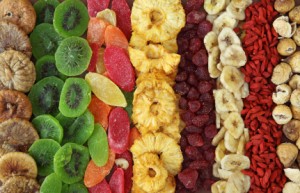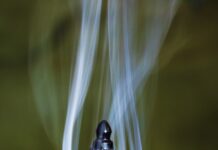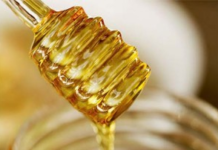
 Drying food concentrates the flavors. Just think of sun-dried tomatoes, and how delicious they are.
Drying food concentrates the flavors. Just think of sun-dried tomatoes, and how delicious they are.
Once food is dry, it is very lightweight, ideal for camping. To run the dehydrator (which is optional, as you can dry in the sun on drying racks), you don’t need electric power again, making a stash of dried food a great resource for disaster preparedness.
Heat: The United States Department of Agriculture recommends a steady heat of 140F for drying food. While this is a little higher than some books recommend, mold growth is inhibited at 140F, an important bonus.
Time: Give the drying process the time it needs. Interrupting it could encourage mold growth. If you have an electric food dehydrator, keep the dehydrator goimg continuously until the food is dried. The faster food is dried, the more nutrients it maintains.
Air Circulation: When food dries, moisture is pulled to the food’s surface, where it evaporates. When surrounding air doesn’t circulate–in a fanless electric dehydrator in the oven with the door closed–moisture clings to the surface and mold grows.
General Drying Procedure
Wash, core, and remove stems of ripe fruit or vegetables to be dried.
Cut the produce into uniform, thin slices. This important, as thicker sections take longer to dry than others, overdrying some parts and under-drying others.
Blanch vegetables or acid-treat fruit, as descried earlier in the chapter.
Place fruits and vegetables on dryer trays. Lay them in one layer, without overlapping.
Start the drying process, e it in the sun, oven, or an electric food dehydrator.
If you are using a solar drying method, remember to ring the food in before dusk and place in a warm oven–lowest setting possible–for the night.
Discard any dried food that appears moldy. Most dried food lasts for six to nine months.
Food enzymes are destroyed with food temperatures reach 118-120F or higher. Raw foodists and others want to make sure to retain enzymes in their food and often ask if dehydration will kill enzymes or not.
Recent research by one company that manufacturers dehydrators suggests that it is actually better to begin the dyhydration process at 145F. While the food is dehydrating, it “sweats out” moisture and reduces temperatures in the dehydrator by 20-25F, thereby not killing enzymes. An advantage of working with temperatures of 145F is that mold growth is also inhibited.
–Adapted from True Food, by Annie B. Bond, Melissa Breyer, Wendy Gordon (National Geographic, 2010).



